Karametra, God of Harvests art by Eric Deschamps
Greatness, At Various Costs
Hopefully I don't sound like a broken record when I tell you that I love building packages (i.e. groups of related cards that can be searched for by a central card) in Commander. "Really Bryce," some of you might say, "I didn't catch on to that when you built two decks with Curse packages. Or when you built three decks with Trinket MageTrinket Mage packages in them."
That's all well and good, but today we're taking packages to the next level. Since its release in Hour of Devastation, I've wanted to build around Uncage the MenagerieUncage the Menagerie, which is most effective when we carefully monitor the converted mana costs of our various creatures. With Uncage in mind, I looked to other prominent cards that synergize with well-engineered mana curves: former Modern boogeyman Birthing PodBirthing Pod, Pod's little sibling Eldritch EvolutionEldritch Evolution, or that lover of utility creatures Woodland BellowerWoodland Bellower. To utilize these cards, I needed a commander that was at least green, cared about creatures, and ideally, could help us ramp. Karametra, God of HarvestsKarametra, God of Harvests fulfilled all of these needs.
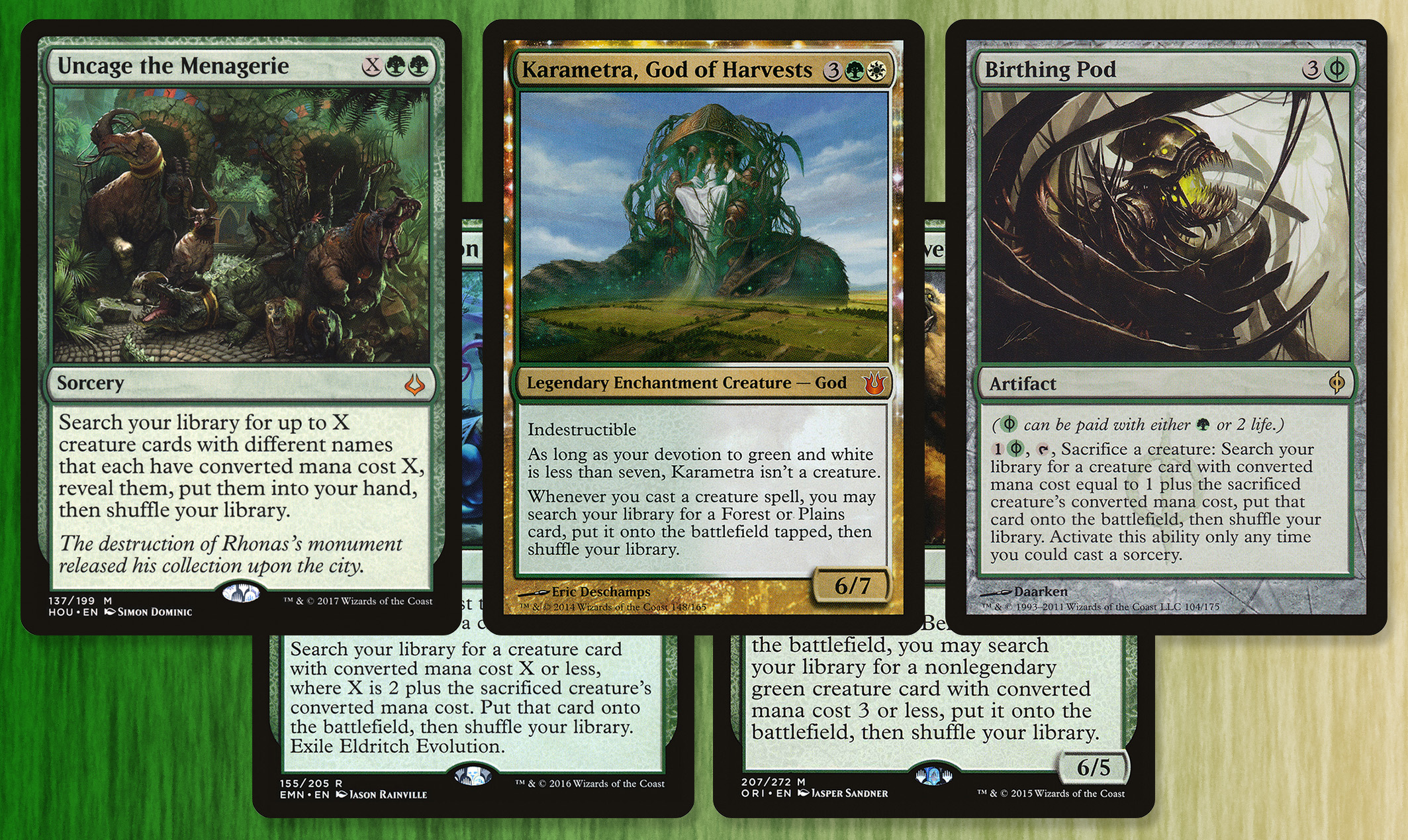
To put this deck together, I took a much different angle than the usual categorical-breakdown-of-needs. Instead, I looked at creatures of progressively larger converted mana costs and selected the best ones to build our curve. Let's step through each stop in that process and see what kind of budget deck we can craft!
Converted Mana Cost = 1
In many formats, ramp is king, and Commander is no exception. We have two "mana dorks": Elvish MysticElvish Mystic and Avacyn's PilgrimAvacyn's Pilgrim, who generates white mana instead of green. This low in the curve we can find powerful effects but usually with some additional cost. Caustic CaterpillarCaustic Caterpillar is one of those, and it begins the trend of having removal all throughout our curve. Ulvenwald TrackerUlvenwald Tracker can provide repeatable, instant-speed removal so long as we have a decent creature. Sylvan SafekeeperSylvan Safekeeper exchanges land for creature protection. This deck isn't as well-suited for him as a Titania, Protector of ArgothTitania, Protector of Argoth deck is, but Karametra means we won't be hurting for lands if we have a win condition to protect.
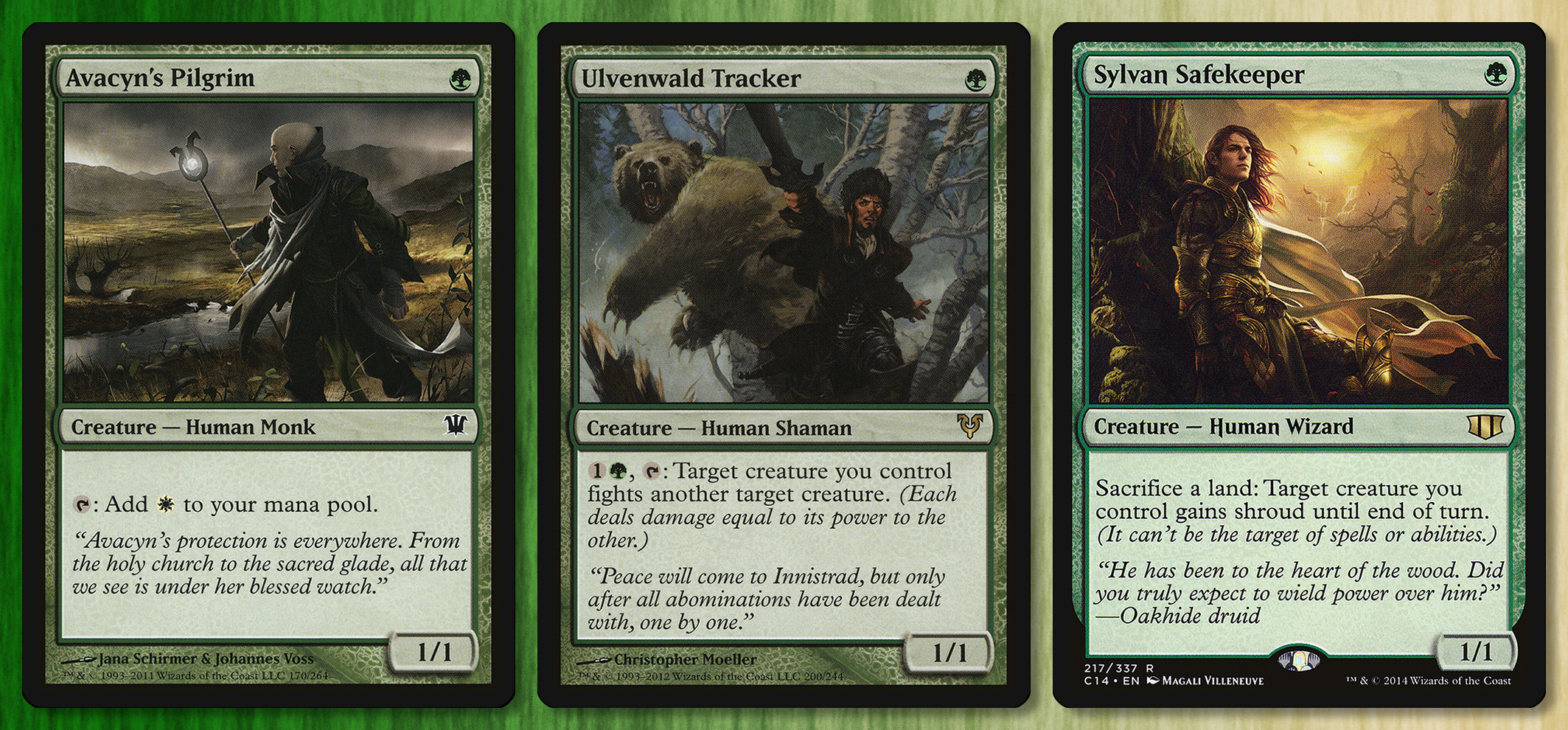
As we progress further in the creature curve, you will see time and time again how we're building to keep our options open. It's not often that we'll cast Uncage the MenagerieUncage the Menagerie with X = 1, but if we find ourselves pressed to do so, there are plenty of useful targets.
Converted Mana Cost = 2
This spot in the curve has a couple of great Karametra staples. Elvish VisionaryElvish Visionary and Wall of BlossomsWall of Blossoms are straightforward creatures that draw a card upon entry (and get us a land if our commander is out). Whitemane LionWhitemane Lion is, I would argue, Karametra's best card. If unanswered, we can repeatedly cast it and return it to our hand, fetching a land for every two mana we have. Better still, at least three of our curve-based creature tutors can search it up. Oh, and we have artifact/enchantment removal through Qasali PridemageQasali Pridemage.
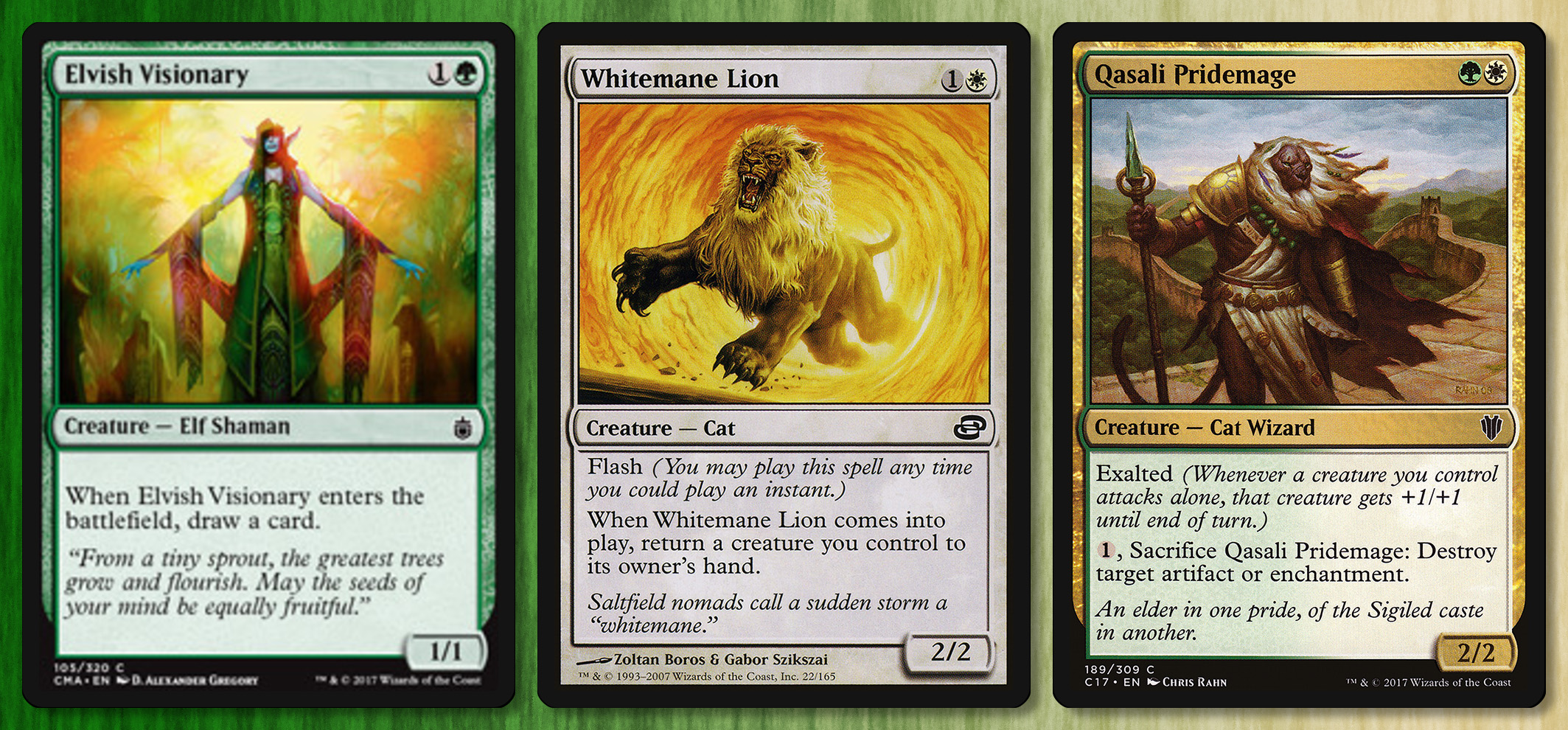
Converted Mana Cost = 3
This section feels like coming home. In addition to being the place where Woodland BellowerWoodland Bellower hits maximum effectiveness, it's also where we find the majority of staple green utility creatures. In a less budget-conscious deck, I would put in Eternal WitnessEternal Witness, but to maintain our bottom line, I've replaced it with the slightly-more-political SkullwinderSkullwinder. Loaming ShamanLoaming Shaman brings that all-important graveyard hate for counteracting recursion-heavy decks. Thanks to her rotation from Standard, card draw engine Tireless TrackerTireless Tracker is much cheaper, and a no-brainer for our deck.
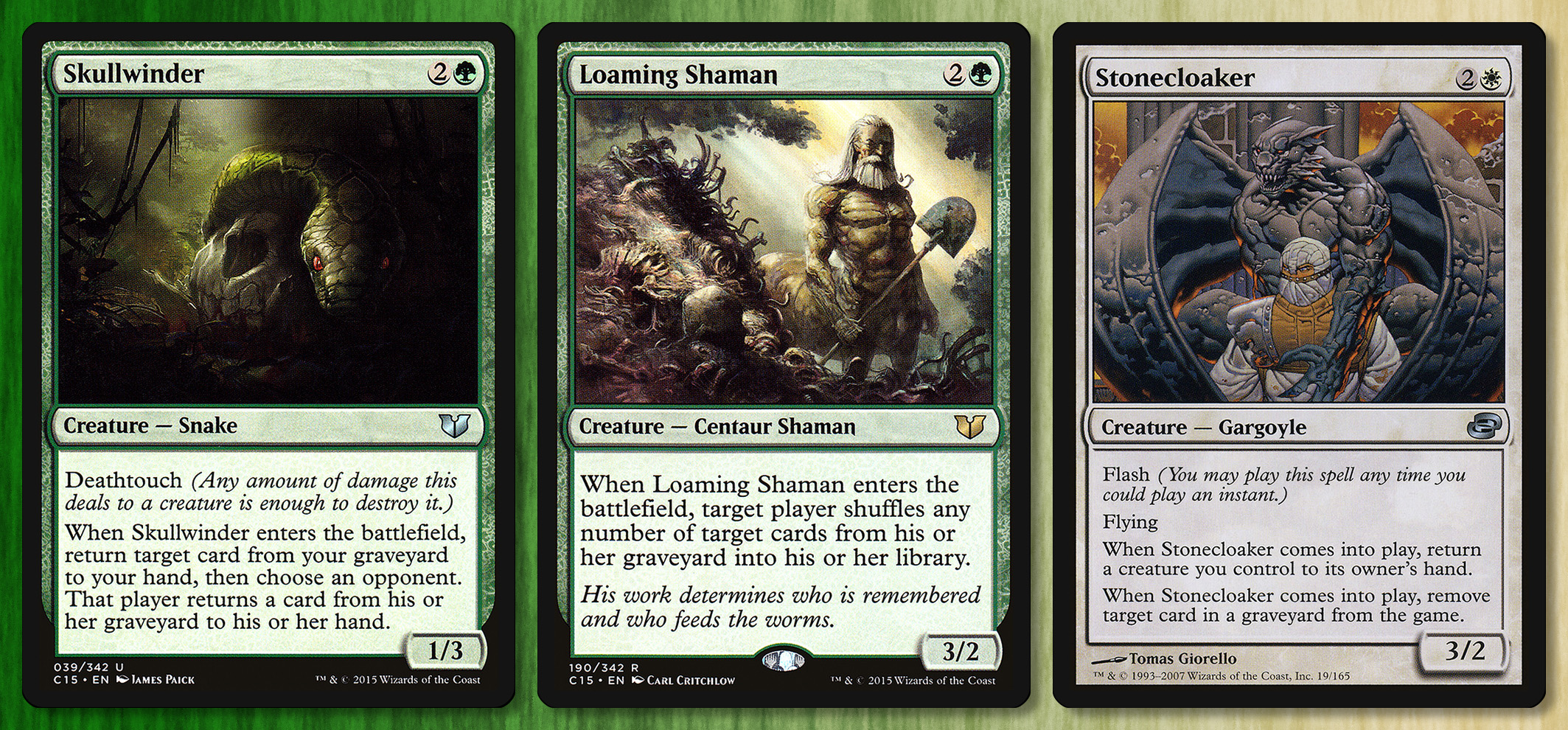
At this section of curve lives another card that cares about curves: Yisan, the Wanderer BardYisan, the Wanderer Bard, an excellent commander in his own right. There's another Karametra staple, StonecloakerStonecloaker, whose niche is similar to Whitemane LionWhitemane Lion but with a side of graveyard hate. Oh, and we have artifact/enchantment removal through Reclamation SageReclamation Sage.
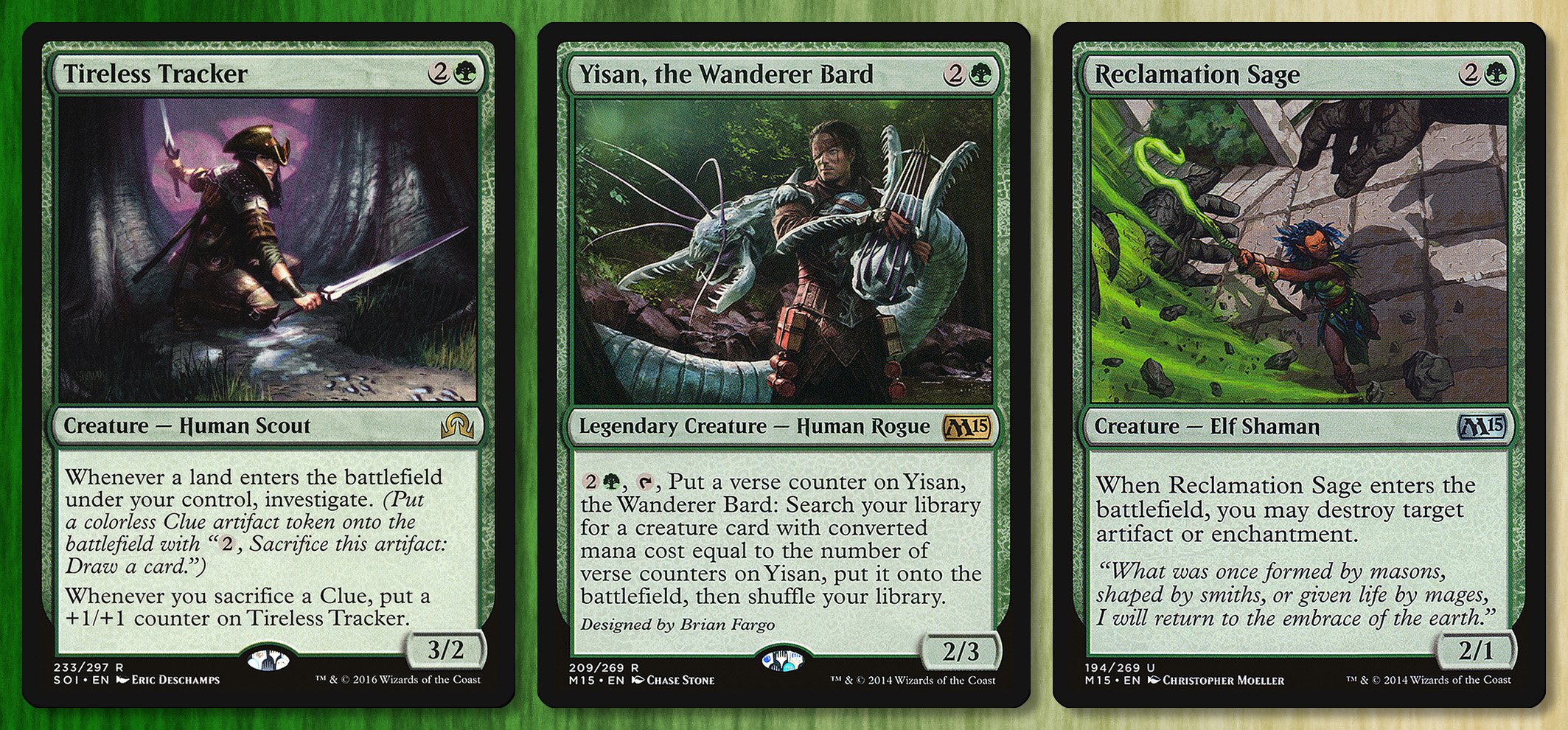
Converted Mana Cost = 4
My favorite card at CMC four loops us back to the beginning: Ranger of EosRanger of Eos searches our library for two creatures with converted mana cost one or less, reaffirming the usefulness of options low in our curve. I included Felidar GuardianFelidar Guardian for its ability to reuse any other enter-the-battlefield effect we have knocking around. No artifact/enchantment removal this time around, though.
Just kidding! We have (repeatable!) artifact/enchantment removal through Nullmage ShepherdNullmage Shepherd.
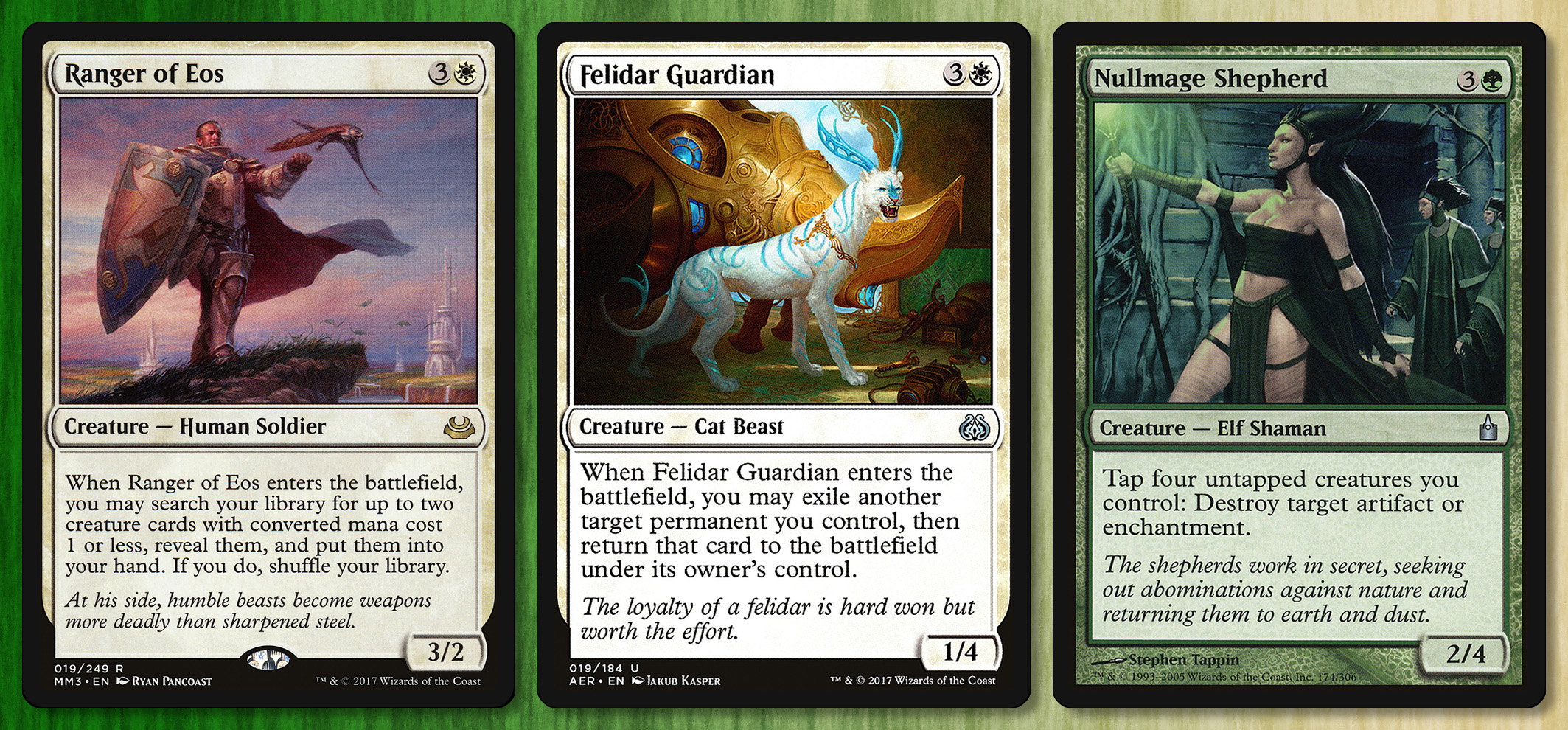
Converted Mana Cost = 5
This is the lightest part of our curve, and could probably serve to be beefed up. This issue is made slightly less problematic by our commander being five mana: if we have enough devotion for Karametra to be a creature, then we can sacrifice her to Birthing PodBirthing Pod or Eldritch EvolutionEldritch Evolution and keep tearing through our curve. There are two other CMC five creatures here. The first is Baru, Fist of KrosaBaru, Fist of Krosa. With enough random utility creatures on our field, a couple Karametra triggers could let us kill a player. Lastly, we have artifact/enchantment/land removal through Acidic SlimeAcidic Slime.
Converted Mana Cost = 6
At long last, the upper echelon of our curve (save for our solitary seven-drop, Emeria ShepherdEmeria Shepherd.) In a deck with so much land-ramp potential, our CMC six friends Baloth WoodcrasherBaloth Woodcrasher, Rampaging BalothsRampaging Baloths, and to a lesser extent Ulvenwald HydraUlvenwald Hydra are all potential win conditions. Two staple card advantage engines live here too: Soul of the HarvestSoul of the Harvest and Primordial SagePrimordial Sage. Our friend Sunblast AngelSunblast Angel acts as a partial creature board wipe. And then... wait for it...
We have (mass) artifact/enchantment removal through Bane of ProgressBane of Progress.
For the curious: no, I did not design this deck with intent to make a stupid parallel structure joke about removal. But who would I be if I wasted such an opportunity?
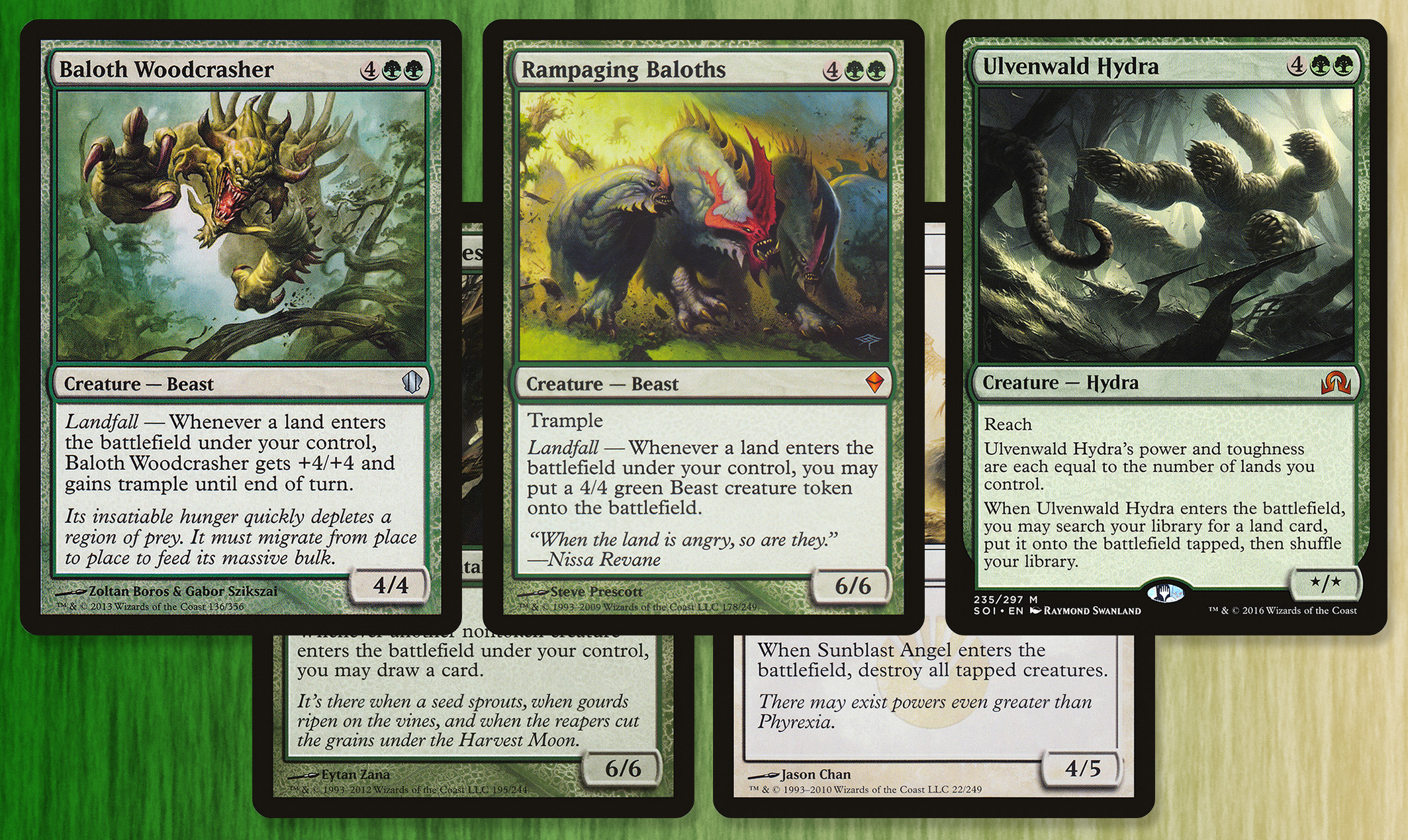
Before we check out with the deck, here's the full creature curve, listed by converted mana cost.
Creatures by CMC
View on Archidekt- 1 Avacyn's Pilgrim *1 Caustic Caterpillar *1 Elvish Mystic *1 Mother of Runes *1 Sylvan Safekeeper *1 Ulvenwald Tracker [/CMC1]Avacyn's Pilgrim *1 Caustic Caterpillar *1 Elvish Mystic *1 Mother of Runes *1 Sylvan Safekeeper *1 Ulvenwald Tracker [/CMC1]
- 1 Elvish Visionary *1 Qasali Pridemage *1 Sakura-Tribe Elder *1 Tajuru Preserver *1 Wall of Blossoms *1 Whitemane Lion [/CMC2]Elvish Visionary *1 Qasali Pridemage *1 Sakura-Tribe Elder *1 Tajuru Preserver *1 Wall of Blossoms *1 Whitemane Lion [/CMC2]
- 1 Burnished Hart *1 Bygone Bishop *1 Farhaven Elf *1 Fiend Hunter *1 Manglehorn *1 Mentor of the Meek *1 Mirror Entity *1 Reclamation Sage *1 Skullwinder *1 Stonecloaker *1 Tireless Tracker *1 Wood Elves *1 Yavimaya Elder *1 Yisan, the Wanderer Bard [/CMC3]Burnished Hart *1 Bygone Bishop *1 Farhaven Elf *1 Fiend Hunter *1 Manglehorn *1 Mentor of the Meek *1 Mirror Entity *1 Reclamation Sage *1 Skullwinder *1 Stonecloaker *1 Tireless Tracker *1 Wood Elves *1 Yavimaya Elder *1 Yisan, the Wanderer Bard [/CMC3]
- 1 Felidar Guardian *1 Kor Cartographer *1 Nullmage Shepherd *1 Ranger of Eos *1 Treasure Keeper [/CMC4]Felidar Guardian *1 Kor Cartographer *1 Nullmage Shepherd *1 Ranger of Eos *1 Treasure Keeper [/CMC4]
- 1 Acidic Slime *1 Baru, Fist of Krosa [/CMC5]Acidic Slime *1 Baru, Fist of Krosa [/CMC5]
- 1 Baloth Woodcrasher *1 Bane of Progress *1 Primordial Sage *1 Rampaging Baloths *1 Soul of the Harvest *1 Sun Titan *1 Sunblast Angel *1 Ulvenwald Hydra *1 Woodland Bellower [/CMC6]Baloth Woodcrasher *1 Bane of Progress *1 Primordial Sage *1 Rampaging Baloths *1 Soul of the Harvest *1 Sun Titan *1 Sunblast Angel *1 Ulvenwald Hydra *1 Woodland Bellower [/CMC6]
- 1 Emeria Shepherd [/CMC7]Emeria Shepherd [/CMC7]
Checking Out
Karametra CMC (By Category)
View on Archidekt- 1 Karametra, God of Harvests [/Commander]]Karametra, God of Harvests [/Commander]]
- 1 Baloth Woodcrasher *1 Baru, Fist of Krosa *1 Genesis Wave *1 Mirror Entity *1 Rampaging Baloths *1 Retreat to Emeria [/Win Conditions]Baloth Woodcrasher *1 Baru, Fist of Krosa *1 Genesis Wave *1 Mirror Entity *1 Rampaging Baloths *1 Retreat to Emeria [/Win Conditions]
- 1 Bygone Bishop *1 Collective Unconscious *1 Lifecrafter's Bestiary *1 Mentor of the Meek *1 Primordial Sage *1 Rishkar's Expertise *1 Seer's Sundial *1 Shamanic Revelation *1 Soul of the Harvest *1 Tireless Tracker [/Card Advantage]Bygone Bishop *1 Collective Unconscious *1 Lifecrafter's Bestiary *1 Mentor of the Meek *1 Primordial Sage *1 Rishkar's Expertise *1 Seer's Sundial *1 Shamanic Revelation *1 Soul of the Harvest *1 Tireless Tracker [/Card Advantage]
- 1 Birthing Pod *1 Eldritch Evolution *1 Ranger of Eos *1 Uncage the Menagerie *1 Woodland Bellower *1 Yisan, the Wanderer Bard [/Tutors]Birthing Pod *1 Eldritch Evolution *1 Ranger of Eos *1 Uncage the Menagerie *1 Woodland Bellower *1 Yisan, the Wanderer Bard [/Tutors]
- 1 Avacyn's Pilgrim *1 Boundless Realms *1 Burnished Hart *1 Elvish Mystic *1 Farhaven Elf *1 Khalni Heart Expedition *1 Kor Cartographer *1 Metamorphosis *1 Oketra's Monument *1 Rhonas's Monument *1 Sakura-Tribe Elder *1 Ulvenwald Hydra *1 Wood Elves *1 Yavimaya Elder [/Ramp]Avacyn's Pilgrim *1 Boundless Realms *1 Burnished Hart *1 Elvish Mystic *1 Farhaven Elf *1 Khalni Heart Expedition *1 Kor Cartographer *1 Metamorphosis *1 Oketra's Monument *1 Rhonas's Monument *1 Sakura-Tribe Elder *1 Ulvenwald Hydra *1 Wood Elves *1 Yavimaya Elder [/Ramp]
- 1 Acidic Slime *1 Bane of Progress *1 Caustic Caterpillar *1 Fiend Hunter *1 Manglehorn *1 Nullmage Shepherd *1 Qasali Pridemage *1 Reclamation Sage *1 Stonecloaker *1 Sunblast Angel *1 Ulvenwald Tracker [/Removal and Hate]Acidic Slime *1 Bane of Progress *1 Caustic Caterpillar *1 Fiend Hunter *1 Manglehorn *1 Nullmage Shepherd *1 Qasali Pridemage *1 Reclamation Sage *1 Stonecloaker *1 Sunblast Angel *1 Ulvenwald Tracker [/Removal and Hate]
- 1 Emeria Shepherd *1 Seasons Past *1 Skullwinder *1 Sun Titan [/Recursion]Emeria Shepherd *1 Seasons Past *1 Skullwinder *1 Sun Titan [/Recursion]
- 1 Elvish Visionary *1 Felidar Guardian *1 Mother of Runes *1 Sylvan Safekeeper *1 Tajuru Preserver *1 Treasure Keeper *1 Wall of Blossoms *1 Whitemane Lion [/MiscellaneousElvish Visionary *1 Felidar Guardian *1 Mother of Runes *1 Sylvan Safekeeper *1 Tajuru Preserver *1 Treasure Keeper *1 Wall of Blossoms *1 Whitemane Lion [/Miscellaneous
- 1 Canopy Vista *1 Field of Ruin *1 Krosan Verge *1 Mosswort Bridge *1 Myriad Landscape *1 Rogue's Passage *1 Scattered Groves *1 Windbrisk Heights *15 Plains *17 Forest [/Lands]Canopy Vista *1 Field of Ruin *1 Krosan Verge *1 Mosswort Bridge *1 Myriad Landscape *1 Rogue's Passage *1 Scattered Groves *1 Windbrisk Heights *15 Plains *17 Forest [/Lands]
Karametra CMC (By Card Type)
View on Archidekt- 1 Karametra, God of Harvests [/Commander]Karametra, God of Harvests [/Commander]
- 1 Acidic Slime *1 Avacyn's Pilgrim *1 Baloth Woodcrasher *1 Bane of Progress *1 Baru, Fist of Krosa *1 Burnished Hart *1 Bygone Bishop *1 Caustic Caterpillar *1 Elvish Mystic *1 Elvish Visionary *1 Emeria Shepherd *1 Farhaven Elf *1 Felidar Guardian *1 Fiend Hunter *1 Kor Cartographer *1 Manglehorn *1 Mentor of the Meek *1 Mirror Entity *1 Mother of Runes *1 Nullmage Shepherd *1 Primordial Sage *1 Qasali Pridemage *1 Rampaging Baloths *1 Ranger of Eos *1 Reclamation Sage *1 Sakura-Tribe Elder *1 Skullwinder *1 Soul of the Harvest *1 Stonecloaker *1 Sun Titan *1 Sunblast Angel *1 Sylvan Safekeeper *1 Tajuru Preserver *1 Tireless Tracker *1 Treasure Keeper *1 Ulvenwald Hydra *1 Ulvenwald Tracker *1 Wall of Blossoms *1 Whitemane Lion *1 Wood Elves *1 Woodland Bellower *1 Yavimaya Elder *1 Yisan, the Wanderer Bard [/Creatures]Acidic Slime *1 Avacyn's Pilgrim *1 Baloth Woodcrasher *1 Bane of Progress *1 Baru, Fist of Krosa *1 Burnished Hart *1 Bygone Bishop *1 Caustic Caterpillar *1 Elvish Mystic *1 Elvish Visionary *1 Emeria Shepherd *1 Farhaven Elf *1 Felidar Guardian *1 Fiend Hunter *1 Kor Cartographer *1 Manglehorn *1 Mentor of the Meek *1 Mirror Entity *1 Mother of Runes *1 Nullmage Shepherd *1 Primordial Sage *1 Qasali Pridemage *1 Rampaging Baloths *1 Ranger of Eos *1 Reclamation Sage *1 Sakura-Tribe Elder *1 Skullwinder *1 Soul of the Harvest *1 Stonecloaker *1 Sun Titan *1 Sunblast Angel *1 Sylvan Safekeeper *1 Tajuru Preserver *1 Tireless Tracker *1 Treasure Keeper *1 Ulvenwald Hydra *1 Ulvenwald Tracker *1 Wall of Blossoms *1 Whitemane Lion *1 Wood Elves *1 Woodland Bellower *1 Yavimaya Elder *1 Yisan, the Wanderer Bard [/Creatures]
- 1 Birthing Pod *1 Lifecrafter's Bestiary *1 Oketra's Monument *1 Rhonas's Monument *1 Seer's Sundial [/Artifacts]Birthing Pod *1 Lifecrafter's Bestiary *1 Oketra's Monument *1 Rhonas's Monument *1 Seer's Sundial [/Artifacts]
- 1 Khalni Heart Expedition *1 Retreat to Emeria [/Enchantments]Khalni Heart Expedition *1 Retreat to Emeria [/Enchantments]
- 1 Boundless Realms *1 Collective Unconscious *1 Eldritch Evolution *1 Genesis Wave *1 Metamorphosis *1 Rishkar's Expertise *1 Seasons Past *1 Shamanic Revelation *1 Uncage the Menagerie [/Sorceries]Boundless Realms *1 Collective Unconscious *1 Eldritch Evolution *1 Genesis Wave *1 Metamorphosis *1 Rishkar's Expertise *1 Seasons Past *1 Shamanic Revelation *1 Uncage the Menagerie [/Sorceries]
- 1 Canopy Vista *1 Field of Ruin *1 Krosan Verge *1 Mosswort Bridge *1 Myriad Landscape *1 Rogue's Passage *1 Scattered Groves *1 Windbrisk Heights *15 Plains *17 Forest [/Lands]Canopy Vista *1 Field of Ruin *1 Krosan Verge *1 Mosswort Bridge *1 Myriad Landscape *1 Rogue's Passage *1 Scattered Groves *1 Windbrisk Heights *15 Plains *17 Forest [/Lands]
Wrecking the Curve
Our careful curving can be only matched by our careful budgeting: this deck goes for about $60.00 according to TCG Mid prices. I encourage readers to comb through the full decklists to examine some of the excellent noncreature cards that we didn't have time to discuss. For the deck on Tapped Out, check out this link. Questions for me? Find me on Twitter, or shoot me an email. And, until next we meet, enjoy your time browsing the Low Market.
Quinn Miller
Quinn Miller (@Walking_Atlas) is a game developer and prolific Commander deckbuilder. When she isn't playing games, she's probably singing, or acting, or both.
Your opinions are welcome. We love hearing what you think about Magic! We ask that you are always respectful when commenting. Please keep in mind how your comments could be interpreted by others. Personal attacks on our writers or other commenters will not be tolerated. Your comments may be removed if your language could be interpreted as aggressive or disrespectful. You may also be banned from writing further comments.
